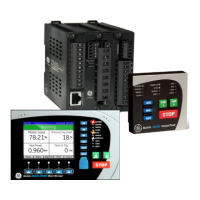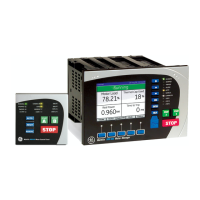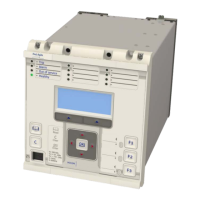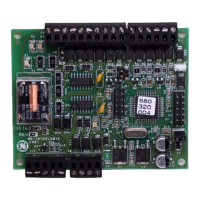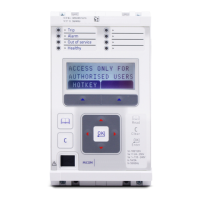The figure describes the behaviour of a power system with parallel lines connecting two sources of generation.
● Curve 1 represents pre-fault system operation through parallel lines where the transmitted power is Po.
● Curve 2 represents transmitted power during a phase-phase-earth fault.
● Curve 3 represents a new power curve when the faulted line is tripped.
At fault inception, the operating point A moves to B, which is a reduced power transfer level. There is, therefore, a
surplus of power (A to B) at that sending end and a corresponding deficit of power at the receiving end. The
sending end generators start to speed up, and the receiving end generators start to slow down, so the phase
angle θ increases, and the operating point moves along curve 2 until the fault is cleared (point C). At this point, the
phase angle is θ1. The operating point now moves to point D on curve 3 which represents the power transfer curve
when just one line is in service. There is still a power surplus at the sending end and a deficit at the receiving end,
so the generators continue to lose synchronism and the operating point moves further along curve 3.
If, at some point between E and G (point F) the generators are rotating at the same speed, the phase angle will
stop increasing. According to the Equal Area Criterion, this occurs when Area 2 is equal to Area 1. The sending end
will now start to slow down and receiving end to speed up. Therefore, the phase angle starts to decrease and the
operating point moves back towards E. As the operating point passes E, the net sending end deficit again becomes
a surplus and the receiving end surplus becomes a deficit, so the sending end generators begin to speed up and
the receiving end generators begin to slow down. With no losses, the system operating point will oscillate around
point E on curve 3, but in practise the oscillation is damped, and the system eventually settles at operating point E.
So, if Area 1 is less than Area 2, the system will oscillate but will stay in synchronism. This swing is usually called a
recoverable, or stable, power swing. If, on the contrary, the system passes point G with a further increase in angle
difference between sending and receiving ends, the system loses synchronism and becomes unstable. This will
happen if the initial power transfer Po is so high that the Area 1 is greater than Area 2. This power swing is not
recoverable and is usually called an Out-of-Step condition or a Pole Slip condition. In such a case, only system
separation and subsequent re-synchronising of the generators can restore normal system operation.
The point G is shown at approximately 120°, but this can vary. If, for example, the pre-fault transmitted power (Po)
was high and the fault clearance was slow, Area 1 would be greater. For the system to recover from this case, the
angle θ would be closer to 90º. Similarly, if the pre-fault transmitted power Po was low and fault clearance fast,
Area 1 would be small, and the angle θ could go closer to 180º with the system remaining stable.
P543i/P545i Chapter 10 - Power Swing Functions
P54x1i-TM-EN-1 271
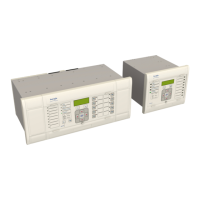
